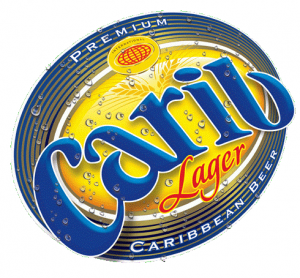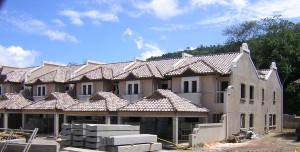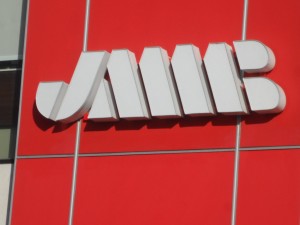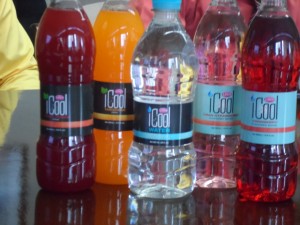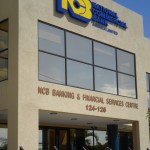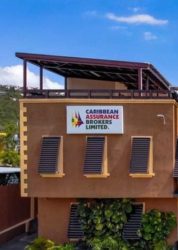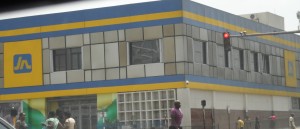 The real estate industry is set to get a boost as Jamaica National Building Society is set to announce a lowering mortgage rates, IC Insider.com has been reliably informed. The announcement could come as early as next week IC Insider.com has learnt.
The real estate industry is set to get a boost as Jamaica National Building Society is set to announce a lowering mortgage rates, IC Insider.com has been reliably informed. The announcement could come as early as next week IC Insider.com has learnt.
Details were not available, but from indications it could result in the current flagship rate of 9.5 percent dropping to 8.5 percent. The move will be a welcomed for the society’s borrowers and will act as a stimulus to the housing market that has seen increased building cost as a result of the falling value of the Jamaican dollar pushing the cost of housing upwards. The decline will come against the background of lowering of repo rates by the country’s central bank and a continuous lowering of Treasury bill rates since early 2014.
The move by Jamaica National is expected to see other long term lenders following the JN lead and should result in an all round fall in borrowing cost for mortgages.
Real estate to get a boost
New low for Jamaican $ on Tuesday
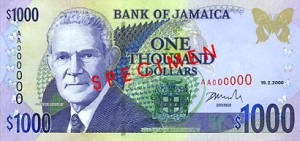 The Jamaican dollar slipped to its lowest level against the US dollar at the end of trading on Tuesday, with the local currency ending at $119.06 to buy the green back. Trading ended in the foreign exchange market with the equivalent of US$29,680,202 bought by dealers, compared with US$45,002,605 on Monday, while they sold the equivalent of US$37,843,436, versus US$35,574,946 previously.
The Jamaican dollar slipped to its lowest level against the US dollar at the end of trading on Tuesday, with the local currency ending at $119.06 to buy the green back. Trading ended in the foreign exchange market with the equivalent of US$29,680,202 bought by dealers, compared with US$45,002,605 on Monday, while they sold the equivalent of US$37,843,436, versus US$35,574,946 previously.
In US dollar trading , dealers bought US$26,694,055 compared to US$40,969,765 on Monday. The buying rate for the US dollar fell 4 cents to $118.33 and US$36,211,236 was sold versus US$34,148,900 on Monday, the selling rate climbed 7 cents to close at $119.06 The Canadian dollar buying rate lost $1.08 to end at $86.46, with dealers buying C$784,688 and selling C$652,773, at an average rate that fell 17 cents to $88.67. 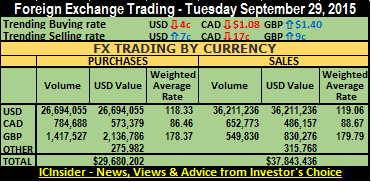 The rate for buying the British Pound rose $1.40 to $178.37 for the purchase of £1,417,527, while £549,830 was sold, at an average rate that rose 9 cents to $179.79. At the end of trading, it took J$133.37 to purchase the Euro, with a rise of 38 cents from Monday’s rate, according to data from Bank of Jamaica, while dealers purchased the European common currency at J$130.68, for a gain of 31 cents from Monday’s rate. The US dollar equivalent of other currencies traded, amounts to US$275,982 being bought, while US$315,768 was sold.
The rate for buying the British Pound rose $1.40 to $178.37 for the purchase of £1,417,527, while £549,830 was sold, at an average rate that rose 9 cents to $179.79. At the end of trading, it took J$133.37 to purchase the Euro, with a rise of 38 cents from Monday’s rate, according to data from Bank of Jamaica, while dealers purchased the European common currency at J$130.68, for a gain of 31 cents from Monday’s rate. The US dollar equivalent of other currencies traded, amounts to US$275,982 being bought, while US$315,768 was sold.
Highs & Lows| The highest buying rate for the US dollar fell 20 cents on Tuesday to $119.30, the lowest buying rate was unchanged at $97.44, the highest selling rate dropped $2.23 to $122.64 while the lowest selling rate dived $12.17 to $87.20. 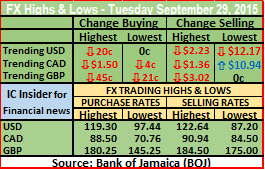 he highest buying rate for the Canadian dollar dipped $1.50 to $88.50, the lowest buying rate lost 4 cents to $70.76, the highest selling rate fell $1.36 to end at $90.94 and the lowest selling rate jumped $10.94 to $84.50. The highest buying rate for the British Pound, lost 45 cents to end at $180.25. The lowest buying rate lost 21 cents to $145.25, the highest selling rate dropped $3.02 to $184.50 and the lowest selling rate remained unchanged at $175.
he highest buying rate for the Canadian dollar dipped $1.50 to $88.50, the lowest buying rate lost 4 cents to $70.76, the highest selling rate fell $1.36 to end at $90.94 and the lowest selling rate jumped $10.94 to $84.50. The highest buying rate for the British Pound, lost 45 cents to end at $180.25. The lowest buying rate lost 21 cents to $145.25, the highest selling rate dropped $3.02 to $184.50 and the lowest selling rate remained unchanged at $175.
Big island states poor currency performers
The smaller economies within the Caribbean region appear to be better managed than the larger economies in the region. IC Insider.com looked at the exchange movements of Jamaica, Costa Rica, Guyana and Dominica Republic between 1972 to date, to see how they performed against each other.
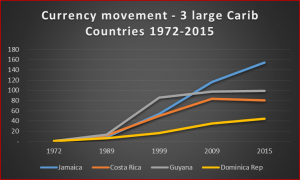 No studies appear to be have been done on this feature of the region and the major reasons why large states seems to be managed so poorly compared to the much smaller ones. The major movement in exchange rates of the countries’ currencies against the United States dollar speaks eloquently of the differences in management quality or could it be that the larger countries are much more difficult to manage? The smaller islands of Barbados, the Eastern Caribbean and the Cayman Islands have maintained the value of their currencies to that of the US from 1972 until now.
No studies appear to be have been done on this feature of the region and the major reasons why large states seems to be managed so poorly compared to the much smaller ones. The major movement in exchange rates of the countries’ currencies against the United States dollar speaks eloquently of the differences in management quality or could it be that the larger countries are much more difficult to manage? The smaller islands of Barbados, the Eastern Caribbean and the Cayman Islands have maintained the value of their currencies to that of the US from 1972 until now.
At the beginning of 1972 it took 6.635 colon to purchase one United States dollar, by 1989, the amount increased to 79.7335 colon for an increase of 12 times the 1972 value. By the end of 1999 it required 50 times the amount in 1972 or 331.796 colons to buy the US dollar. By 2009 it took 554.5 colon to buy the US dollar or 83.6 times the amount in 1972. As of September this year it requires 80.2 times the amount in 1972 to purchase the US dollar which trades at 532.45 colon to US$1.
In the case of Guyana it took GY$2.087 in 1972 to buy the Us dollar but by 1989 it required 13.4 times the amount as in 1972 as the rate slipped to GY$27.95. By 1999 it was taking GY$178.63 or 85.6 times the 1972 figure, for the next ten years the change slowed markedly to GY$202.876 or 97 times the 1972 and in September 2015 the rate inched up to GY$205.79.
In the case of Dominican Republic it took 1 peso in 1972 to buy the Us dollar but by 1989 it required 6.53 times the amount as in 1972 as the rate slipped to 6.53 pesos. By 1999 it was taking 16.09 or 16 times the 1972 figure. By 1999 the Dominican peso fell further in value, requiring 35.35 pesos or 35 times the 1972 figure to buy the buck. In September 2015 the rate climbed to 44.26 pesos to the US dollar or 44 times the amount in 1972.
Jamaica has turned out to be by far, the worst performing currency in the Caribbean region since 1972 and probably the worst managed economy. Between 1972 and September this year, it takes 154.55 more Jamaican dollar to buy one United States dollar as the country’s economy has performed poorly. Having been trading at 77 Jamaican cents to the US dollar for a number of years, by the January 10, 1973, the Jamaican dollar was devalued by 15 percent to 91 cents to one US dollar. On the January 13, 1978, the official rate had moved to $1.05, by May 10, the rate ended at $1.55 and ended at $1.69 on the last day of the year. On May 2, 1979 the rate moved to $1.78 where it stayed until November 1983, at which stage the rate moved to $3.15. By 1985 the rate climbed to $5.50 and to $6.50 by the end of 1989, taking 365 percent more Jamaican dollars to buy the US dollar, since 1983 and requiring 8.44 times the amount in 1972.
Ten years later in 1999, the rate reached $41.42, requiring 637 percent more local currency to but one US dollar than ten years before, and 53.8 times the amount in 1972. By the end of 2009, the rate moved to $89.60, requiring just over twice the amount of Jamaican dollars for one US dollar. At the end of trading on Friday September 25, 2015 at just over $119 to 1 US dollar for the first time, requiring 33 percent more Jamaican dollars to purchase the US dollar, than at the end of 2009.
Economy estimated to fall 2% to June.
The report went on to state, “continued shortfalls in natural gas production saw the energy sector decline by an estimated 3 ½ percent in the first six months of 2015. The non-energy sector, which has provided support to the overall economy for the past few years lost momentum, declining by around 1 percent in the first half of 2015. This decline was mainly due to a slowdown in construction, distribution and manufacturing. Early indicators point to continued sluggish economic performance in the third quarter of 2015.”
Trinidad and Tobago’s economy is highly dependent on the petro chemical industries and has suffered from a sharp fall in the world market prices of produce from the sector. This decline was mainly due to a slowdown in construction, distribution and manufacturing. Government revenues are highly dependent on inflows from the sector. The expectation is for lower government spending going forward and the possibility of a devaluation of the country’s currency that has undergone an appreciation with the local dollar being stable for several years while inflation climbed sharply, leading to a possible overvalued Trinidad dollar. The country just changed governments and that could bring major shift in economic policies against the back ground of falling export earnings and the possibility that oil prices could fall some more on the world market.
With excess liquidity remaining at a comfortable daily average of $3.3 billion over the past three months (July – September 21, 2015), the MPC also decided to maintain an aggressive liquidity management programme so as to strengthen the impact of rising interest rates throughout the financial system. As at mid-September 2015, the median commercial bank prime lending rate had increased to 8 ½ percent from 8 ¼ percent in July 2015.
Domestic inflationary pressures have not materialized as initially expected. On a year-on-year basis to August 2015, headline inflation slowed to 4 percent from just over 5 ½ percent in July 2015. Core inflation was stable at just over 1 ½ percent, while food inflation decelerated to around 8 percent from double-digit territory of 11 ½ percent in July 2015. Although current price pressures seem contained, disruptions to domestic agricultural supply and higher production costs facing select food industries could lead to rising food inflation. Increased consumer spending driven in part by recently concluded public sector wage agreements, as well as robust consumer borrowing, could also push up inflationary pressures.
From 77 cents to J$119 to US
On January 1973 it took only 77 Jamaican cents to buy one United States dollar, roughly 43 years later it now requires an average of 119 of the local currency to purchase one US dollar. A technical assessment of the currency movement suggests that the fall in the value could be coming to an end sooner than later.
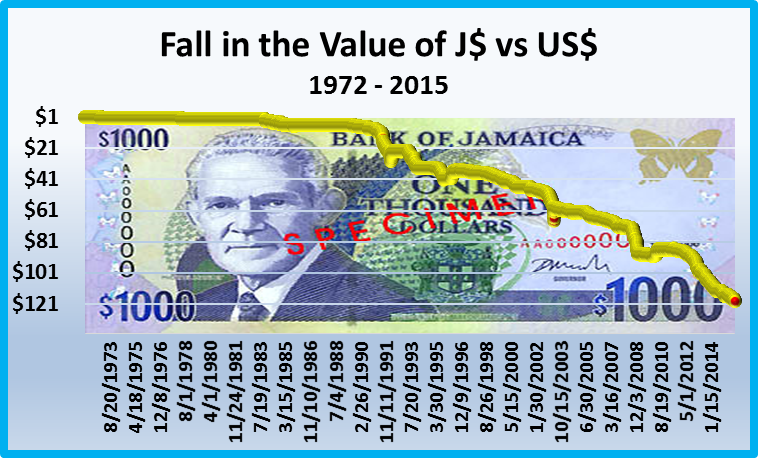 Having being trading at 77 Jamaican cents to the US dollar for a number of years, by the January 10, 1973, the Jamaican dollar was devalued by 15 percent to 91 cents to one US dollar. On the January 13, 1978 the official rate had moved to $1.05, by May 10 the rate ended at $1.55 and ended at $1.69 on the last day of the year. On May 2, 1979 the rate moved to $1.78 where it stayed until November 1983, at which stage the rate moved to $3.15. By 1985 the rate climbed to $5.50 and to $6.50 by the end of 1989, taking 365 percent more Jamaican dollars to buy the US dollar, since 1983. Ten years later in 1999, the rate reached $41.42, requiring 637 percent more local currency to but one US dollar than ten years before and by the end of 2009 it moved to $89.60, requiring just over twice the amount of Jamaican dollars for exchange for one US dollar and at the end of trading on Friday surpassed J$119 to 1 US dollar for the first time, requiring 33 percent more Jamaican dollars to purchase the US dollar, than at the end of 2009.
Having being trading at 77 Jamaican cents to the US dollar for a number of years, by the January 10, 1973, the Jamaican dollar was devalued by 15 percent to 91 cents to one US dollar. On the January 13, 1978 the official rate had moved to $1.05, by May 10 the rate ended at $1.55 and ended at $1.69 on the last day of the year. On May 2, 1979 the rate moved to $1.78 where it stayed until November 1983, at which stage the rate moved to $3.15. By 1985 the rate climbed to $5.50 and to $6.50 by the end of 1989, taking 365 percent more Jamaican dollars to buy the US dollar, since 1983. Ten years later in 1999, the rate reached $41.42, requiring 637 percent more local currency to but one US dollar than ten years before and by the end of 2009 it moved to $89.60, requiring just over twice the amount of Jamaican dollars for exchange for one US dollar and at the end of trading on Friday surpassed J$119 to 1 US dollar for the first time, requiring 33 percent more Jamaican dollars to purchase the US dollar, than at the end of 2009.
Trading ended Friday with the equivalent of US$32,449,484 bought by dealers, compared with US$53,172,006 on Thursday, while they sold the equivalent of US$29,004,619, versus US$58,244,225 previously. In US dollar trading , dealers bought US$30,260,875 compared to US$50,560,723 on Thursday. The buying rate for the US dollar fell 20 cents to $118.45 and US$27,678,764 was sold versus US$56,905,545 on Thursday, the selling rate rose 4 cents to close at $119.02. The Canadian dollar buying rate added 16 cents to $86.92, with dealers buying C$849,774 and selling C$480,605, at an average rate that lost 60 cents to $88.55. The rate for buying the British Pound dropped $1 to $178.09 for the purchase of £965,327, while £529,965 was sold, at an average rate that rose 64 cents to end at $181.41. At the end of trading, it took J$134.31 to purchase the Euro, with a jump of $1.73 on Thursday’s rate, according to data from Bank of Jamaica, while dealers purchased the European common currency at J$131.93, for a rise of $2.06 from Thursday’s rate. The US dollar equivalent of other currencies traded, amounts to US$113,653 being bought, while US$160,542 was sold.
The buying rate for the US dollar fell 20 cents to $118.45 and US$27,678,764 was sold versus US$56,905,545 on Thursday, the selling rate rose 4 cents to close at $119.02. The Canadian dollar buying rate added 16 cents to $86.92, with dealers buying C$849,774 and selling C$480,605, at an average rate that lost 60 cents to $88.55. The rate for buying the British Pound dropped $1 to $178.09 for the purchase of £965,327, while £529,965 was sold, at an average rate that rose 64 cents to end at $181.41. At the end of trading, it took J$134.31 to purchase the Euro, with a jump of $1.73 on Thursday’s rate, according to data from Bank of Jamaica, while dealers purchased the European common currency at J$131.93, for a rise of $2.06 from Thursday’s rate. The US dollar equivalent of other currencies traded, amounts to US$113,653 being bought, while US$160,542 was sold.
Highs & Lows| The highest buying rate for the US dollar dropped $1.38 on Friday to $119.12, the lowest buying rate gained 16 cents to $97.44,  the highest selling rate ended 21 cents higher at $124.87 while the lowest selling rate dived $1.74 lower to $97.45. The highest buying rate for the Canadian dollar rose 69 cents to $89.69, the lowest buying rate dipped $1.03 to $70.43, the highest selling rate climbed 13 cents to end at $91.53 and the lowest selling rate rose 50 cents to $85.50. The highest buying rate for the British Pound, added 12 cents to end at $181.50, the lowest buying rate slipped 12 cents to $145.46, the highest selling rate climbed $1.72 to $187.52 and the lowest selling rate dropped 40 cents to $175.
the highest selling rate ended 21 cents higher at $124.87 while the lowest selling rate dived $1.74 lower to $97.45. The highest buying rate for the Canadian dollar rose 69 cents to $89.69, the lowest buying rate dipped $1.03 to $70.43, the highest selling rate climbed 13 cents to end at $91.53 and the lowest selling rate rose 50 cents to $85.50. The highest buying rate for the British Pound, added 12 cents to end at $181.50, the lowest buying rate slipped 12 cents to $145.46, the highest selling rate climbed $1.72 to $187.52 and the lowest selling rate dropped 40 cents to $175.
12 JSE stocks rise 3 fall on Friday
The main market indices enjoyed a second day of increases with the JSE Market Index gained 680.16 points to 96,507.41, the JSE All Jamaican Composite index added 693.16 points to 106,808.75 and the JSE combined index rose 760.12points to end at 99,739.05.
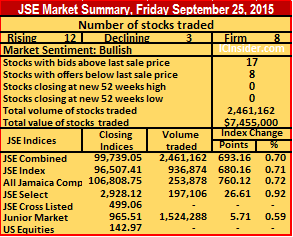 IC bid-offer Indicator| At the end of trading, in the main and junior markets, the Investor’s Choice bid-offer indicator had a reading of 17 stocks with bids higher than their last selling prices and 8 with offers that were lower. This indicator has been increasing in strength over the past week as the period for company results for the third quarter approaches. Notwithstanding, there are still some pockets of weakness as shown by the number of stocks that are offered below their last selling prices.
IC bid-offer Indicator| At the end of trading, in the main and junior markets, the Investor’s Choice bid-offer indicator had a reading of 17 stocks with bids higher than their last selling prices and 8 with offers that were lower. This indicator has been increasing in strength over the past week as the period for company results for the third quarter approaches. Notwithstanding, there are still some pockets of weakness as shown by the number of stocks that are offered below their last selling prices.Stocks that particularly weak are Hardware and Lumber with a last sale of $13 now being offered at $11.50. Grace Kennedy reported earlier in the year that they were considering a buyout offer for the shares thy own in this subsidiary at a maximum price of $18.50 and that the deal should be closed by the end of July, there is no further information on the deal.
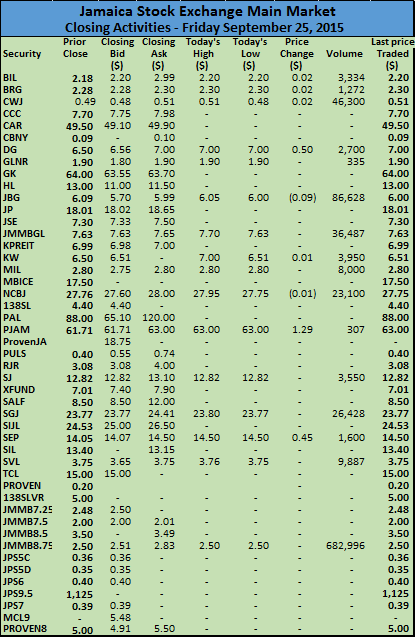 Sterling Investments with a last sale of $13.40 is now on offer at $13.15, at 11 o’clock on Friday morning the amount of stock on offer at the closing quote was 242,600 units a Grace Kennedy that has an offer of $63.70 versus the last traded price of $64.
Sterling Investments with a last sale of $13.40 is now on offer at $13.15, at 11 o’clock on Friday morning the amount of stock on offer at the closing quote was 242,600 units a Grace Kennedy that has an offer of $63.70 versus the last traded price of $64.In trading, Cable and Wireless added 2 cents with 46,300 shares changing hands, to close at 51 cents, Jamaica Broilers had 86,628 units trading at $6 after shedding 9 cents, JMMB Group traded at $7.63 with 36,487 shares changing hands. National Commercial Bank had 23,100 units changing hands and ended at $27.75 while dropping 1 cent, Scotia Group traded 26,428 shares to close at $23.77.
IC Insider was unable to get the closing bids and offer volumes at the close of trading on Friday, accordingly the trading sheet do not carry this information.
Rising JSE stocks outpace decliners Thursday
The main market indices enjoyed a second day of increases with the JSE Market Index gained 89.23 points to 95,827.25, the JSE All Jamaican Composite index added 99.71 points to 106,048.63 and the JSE combined index rose 167.49 points to end at 99,045.89.
IC bid-offer Indicator| At the end of trading, in the main and junior markets, the Investor’s Choice bid-offer indicator had a reading of 16 stocks with bids higher than their last selling prices and 8 with offers that were lower.

This is an indication that while there is buying interest above current prices for a large number of stocks, there are still a noticeable number of stocks that investors want to be out of, at lower prices, than the last selling price.
Stocks that particularly weak are Hardware and Lumber with a last sale of $13 now being offered at $11.50. Grace Kennedy reported earlier in the year that they were considering an offer for this subsidiary at a maximum price of $18.50 and that the deal should be closed by the end of July. To date there has been no further information on the buy out offer, even as the July deadline is long past. Sterling Investments with a last sale of $13.40, now have on offer at $13.15, 242,600 units and no bids to buy.
Trading in the main market ended with Berger Paints trading 20,000 shares at $2.28, Cable and Wireless slipped 1 cent with 10,774,000 shares changing hands, to close at 49 cents. At the close the stock had 1,122,637 units on the bid at 48 cents and 172,996 units on offer at 51 cents. Carreras traded 224,067 shares at $49.50 while gaining 50 cents, Ciboney Group with 4,365,250 shares at 9 cents, Desnoes & Geddes ended with 135,000 shares trading with a 35 cents gain to close at $6.50, Jamaica Broilers had 35,930 units trading at $6.09, JMMB Group traded at $7.63 with 10,984 shares changing ownership.
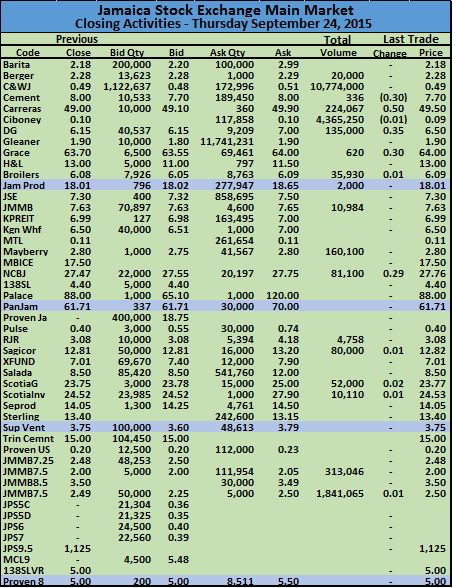 Mayberry Investments had 160,100 shares trading at $2.80, National Commercial Bank had 81,100 units changing hands and ended at $27.76 while losing just 1 cent, Sagicor Group with 80,000 shares trading, closed 1 cent higher at $12.82, Scotia Group traded 52,000 shares to close with a rise of 2 cents to $23.77. Scotia Investments traded 10,110 shares in closing at $24.53 with a gain of 1 cent, Jamaica Money Market Brokers 7.50% preference share 313,046 units at $2 and Jamaica Money Market Brokers 8.75% preference share 1,841,065 units at $2.50 fo a rise of 1 cent.
Mayberry Investments had 160,100 shares trading at $2.80, National Commercial Bank had 81,100 units changing hands and ended at $27.76 while losing just 1 cent, Sagicor Group with 80,000 shares trading, closed 1 cent higher at $12.82, Scotia Group traded 52,000 shares to close with a rise of 2 cents to $23.77. Scotia Investments traded 10,110 shares in closing at $24.53 with a gain of 1 cent, Jamaica Money Market Brokers 7.50% preference share 313,046 units at $2 and Jamaica Money Market Brokers 8.75% preference share 1,841,065 units at $2.50 fo a rise of 1 cent.
Juniors close Thursday on strong note
The market ended with 3 securities with no bids to buy, while 8 had no stocks being offered for sale. A total of 8 stocks closed with bids higher than the last traded prices and 4 closed with lower offers.
In trading, AMG Packaging closed at $3.60 as 36,280 units changed hands, C2W Music had 3,700 units changing hands unchanged at 39 cents, Honey Bun had 2,054 shares trading with a fall of 2 cents to close at $4.28, Lasco Financial with 3,250 shares changing hands rose 6 cents to end at $1.61. Lasco Manufacturing with 15,000 shares trading closed at $1.96 and Eppley cumulative preference share 2019, ended with 31,700 units changing hands at $6.01.
A number of IC Insider BUY RATED stocks are in demand and seems poised to rise these include, Caribbean Cream did not trade but ended with bids in to buy 588,536 shares at $1.68 and
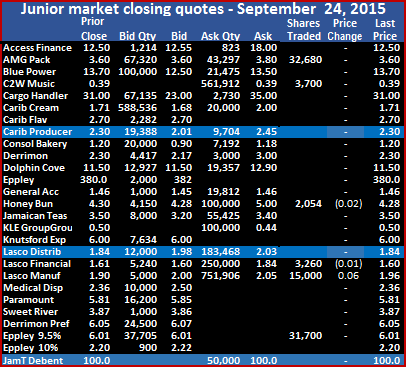 support down to $1.65 with 215,000 shares and with offers for 20,000 units at $2 and between $2.05 and $3 a total of 186,000 shares. Lasco Distributors closed with the offer at $1.98 to buy 12,000 shares by Mayberry Investments for a client, more than the last selling price of $1.84, below that offer, is one for only 4,500 units at $1.90 and 250,000 units at $1.86. There are 4 offers, ranging between $2.03 and $2.05 for a total of 503,000 shares. Lasco Manufacturing has a bid at $2 for a small amount and 321,191 at $1.90, there are 5 offers ranging from $2.05 with 752,000 units and 34,000 units at $2.05 and 17,200 shares at $2.80.
support down to $1.65 with 215,000 shares and with offers for 20,000 units at $2 and between $2.05 and $3 a total of 186,000 shares. Lasco Distributors closed with the offer at $1.98 to buy 12,000 shares by Mayberry Investments for a client, more than the last selling price of $1.84, below that offer, is one for only 4,500 units at $1.90 and 250,000 units at $1.86. There are 4 offers, ranging between $2.03 and $2.05 for a total of 503,000 shares. Lasco Manufacturing has a bid at $2 for a small amount and 321,191 at $1.90, there are 5 offers ranging from $2.05 with 752,000 units and 34,000 units at $2.05 and 17,200 shares at $2.80.
NCB takes big bite off JSE indices
The JSE Market Index dived 1,543.26 points to 96,974.49, the JSE All Jamaican Composite index dropped 1,724.67 points to 107,330.74 and the JSE combined index lost 1,556.88 points to end at 99,983.01.
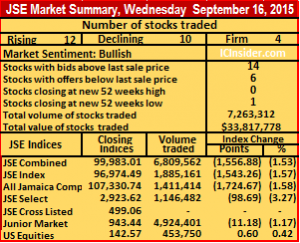 IC bid-offer Indicator| At the end of trading, in the main and junior markets, the Investor’s Choice bid-offer indicator had a reading of 14 stocks with bids higher than their last selling prices and 6 with offers that were lower, indicative of another day of up and down price movements ahead.
IC bid-offer Indicator| At the end of trading, in the main and junior markets, the Investor’s Choice bid-offer indicator had a reading of 14 stocks with bids higher than their last selling prices and 6 with offers that were lower, indicative of another day of up and down price movements ahead.In trading, Cable and Wireless gained 2 cents with 561,804 shares changing hands, to close at 50 cents, Carreras dropped $1.39 but with just 1,685 shares trading at $48.60, Grace Kennedy traded firm at $63.50 with 9,153 shares, Hardware & Lumber dropped $4.50 with 5,000 shares trading at $13. Jamaica Broilers with 318,926 units changing hands, ended at $5.90 while gaining 5 cents, after it traded as high as $7 in the morning session, JMMB Group traded 87,809 units, the price rose 22 cents to end at $7.85,
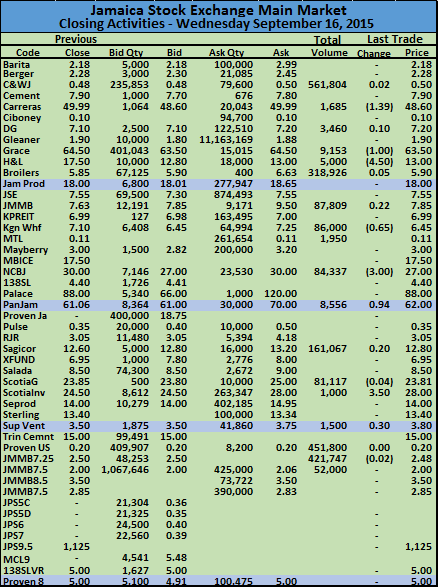 Kingston Wharves had 86,000 units trading with a loss of 65 cents to end at $6.45, National Commercial Bank with 84,337 shares changing hands, closed at $27, having fallen $3, Sagicor Group with 161,067 shares closed 20 cents higher at $12.80, Scotia Group traded 81,117 shares to close with a loss of 4 cents at $23.81, Scotia Investments jumped $3.50 to $28 but with only 1,000 units, Proven Investments ordinary share traded 451,800 units at 20 US cents,Jamaica Money Market Brokers 7.25% preference share traded 421,747 units at $2.48 by losing 2 cents to end at a new 52 weeks’ low and Jamaica Money Market Brokers 7.50% preference share traded 52,000 units at $2.
Kingston Wharves had 86,000 units trading with a loss of 65 cents to end at $6.45, National Commercial Bank with 84,337 shares changing hands, closed at $27, having fallen $3, Sagicor Group with 161,067 shares closed 20 cents higher at $12.80, Scotia Group traded 81,117 shares to close with a loss of 4 cents at $23.81, Scotia Investments jumped $3.50 to $28 but with only 1,000 units, Proven Investments ordinary share traded 451,800 units at 20 US cents,Jamaica Money Market Brokers 7.25% preference share traded 421,747 units at $2.48 by losing 2 cents to end at a new 52 weeks’ low and Jamaica Money Market Brokers 7.50% preference share traded 52,000 units at $2.
IMF – J$ may still be overvalued
 The International Monetary Fund (IMF) is saying that the Jamaican dollar could be overvalued by as much as 19 percent to a moderate rate of 2.1 percent depending on the methods used. The fund also suggest that other methods show an undervaluation of up to 13 percent as well, based on the fall in the price of oil on the world market.
The International Monetary Fund (IMF) is saying that the Jamaican dollar could be overvalued by as much as 19 percent to a moderate rate of 2.1 percent depending on the methods used. The fund also suggest that other methods show an undervaluation of up to 13 percent as well, based on the fall in the price of oil on the world market.
“Preliminary analysis based on the Fund’s EBA-lite and CGER models does not offer clear evidence ofeither over- or undervaluation, after two years of exchange rate adjustment and an important current account adjustment. Safeguarding the gains in competitiveness will be critical in an uncertain global environment. The increased flexibility in exchange rate has been instrumental in improving competitiveness and strengthening the external position. Continued exchange rate depreciation remains necessary given the ongoing inflation differential with trading partners, the risks to competitiveness from a possible upswing in oil prices, and the recent strengthening of the US dollar”, the IMF reported.
 The IMF stated, “the macroeconomic balance (MB) and the external sustainability (ES) approaches suggest that the Real effective exchange rate (REER) is undervalued (at 11.5 and 12.6 percent) while, the equilibrium real exchange rate (ERER) and the purchasing power parity (PPP) approaches point to some remaining overvaluation (of 19.4 per cent and 14.4 percent respectively). A key assumption for the MB and ES estimates is that oil prices will recover only gradually and partially from their recent decline, thereby supporting the projected improvement in the current account balance. The confidence intervals are very large for all the estimates and, statistically, zero misalignment cannot be rejected. The results of the EBA-lite methodology, which estimates the gap between the current account balance and its norm for 2015, suggest a slight overvaluation” of 2.1 percent. These overvaluation amounts would require adjustments for inflation differential between Jamaica and our main trading partners, which could mean roughly a 5 percent adjustment to the rate of exchange.
The IMF stated, “the macroeconomic balance (MB) and the external sustainability (ES) approaches suggest that the Real effective exchange rate (REER) is undervalued (at 11.5 and 12.6 percent) while, the equilibrium real exchange rate (ERER) and the purchasing power parity (PPP) approaches point to some remaining overvaluation (of 19.4 per cent and 14.4 percent respectively). A key assumption for the MB and ES estimates is that oil prices will recover only gradually and partially from their recent decline, thereby supporting the projected improvement in the current account balance. The confidence intervals are very large for all the estimates and, statistically, zero misalignment cannot be rejected. The results of the EBA-lite methodology, which estimates the gap between the current account balance and its norm for 2015, suggest a slight overvaluation” of 2.1 percent. These overvaluation amounts would require adjustments for inflation differential between Jamaica and our main trading partners, which could mean roughly a 5 percent adjustment to the rate of exchange.
- « Previous Page
- 1
- …
- 471
- 472
- 473
- 474
- 475
- …
- 489
- Next Page »
